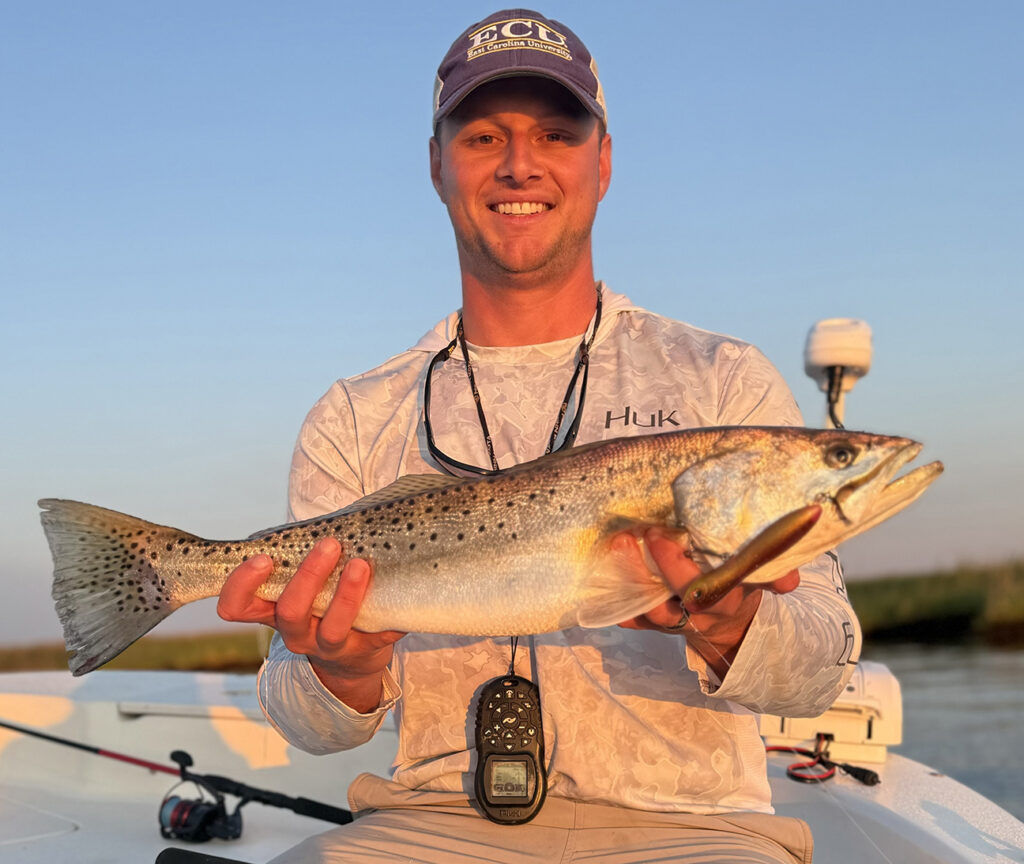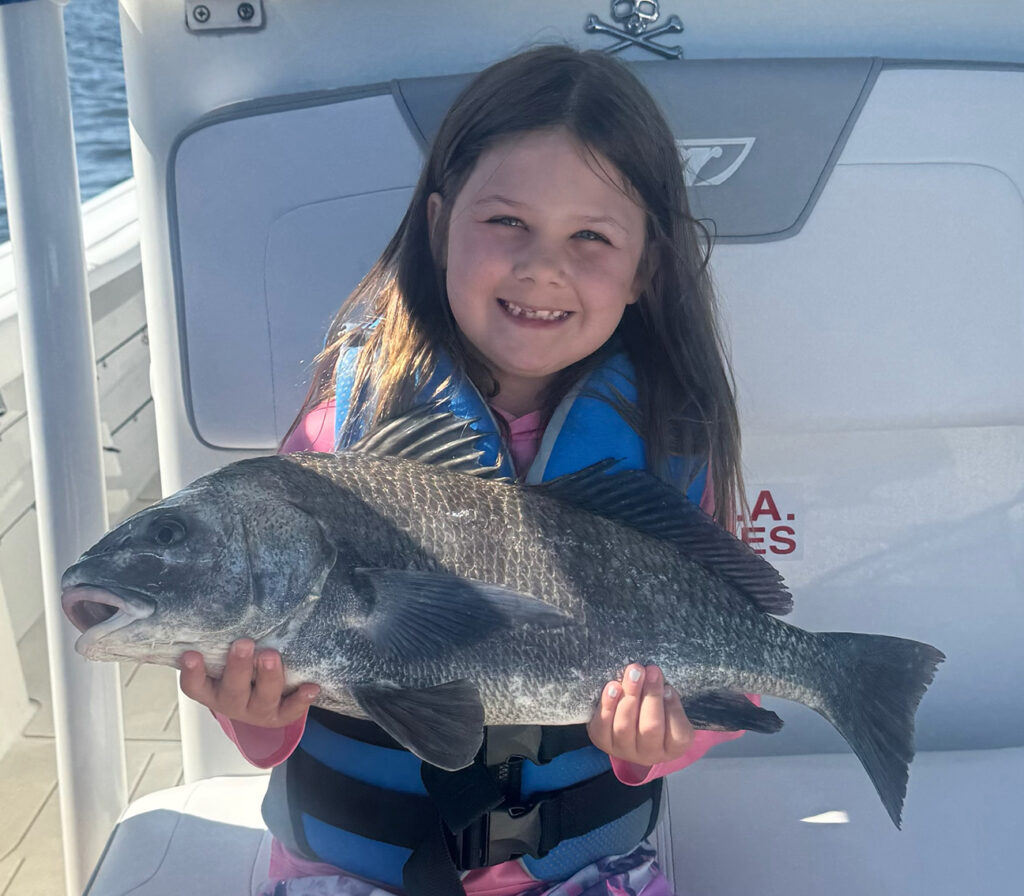Pamlico/Neuse River – July 2025
Donald, of Custom Marine Fabrication, reports that red drum (a few (40”+) are showing up, and anglers are having success working the banks with a wide variety of natural and artificial baits.
Big bluefish are in the river, and they’re providing action on jigs and topwater plugs.
More stingrays are around than normal this year, and a couple tarpon have already been spotted.
Speckled trout remain downriver and in the sound after they moved to those grass flats to spawn over the spring.
Brad, of Gunny B Outdoors, reports that red drum fishing is strong, and topwater plugs are a great summertime bait that anglers can use to quickly scout an area. Popping corks with soft plastics is the other most reliable setup for a day out fishing the Neuse because it’s simple and produces bites from any gamefish species in the area. If water levels are lower, try focusing on the slightly deeper (2-3’+) flats and banks.
Down towards the sound, anglers can find spanish mackerel and bluefish.
Tarpon are around, and the right bait at the right time can get a bonus hookup. A tarpon recently even hit a topwater plug.
Dave, of Pamlico Pirate Charters, reports that a run of southwest winds has kept water levels lower in the Neuse River area. Finding deeper spots is key when these conditions present.
Large speckled trout hookups on live menhaden are common, with topwater plugs having success early. The best fishing action is in the main river, with the occasional creek mouth pushing out a bite. Ledges, stumps, docks, and flats all increase success.
Red drum are being caught by floating live bait under a cork in the river. Big red drum are already showing up, so it’s a good idea to use at least a 4000 class reel in case of hooking into one of these bulls.
Black drum are out in the sound for anglers fishing structures downriver.
Flounder are mixed in, mostly as bycatch when fishing with live bait.

Chandler Eberly, of Gardner, caught (and released) this 24″ speckled trout in the Pamlico Sound on a peanut-shaped topwater.
Gary, of Spec Fever Guide Service, reports that working shallow shorelines (less than 4’) can produce a mixed bag of red drum, speckled trout, flounder, and bluefish. The key is focusing on areas with bait. Topwater plugs, popping cork setups, or soft plastics on jig heads will entice strikes. Color patterns don’t seem to matter, but white and chartreuse to counter the tannic water is helpful.
Kent, of East Side Bait and Tackle, reports that anglers are having success targeting red drum on the Pamlico River shorelines. Cut and/or live menhaden or mullet, topwater plugs, and popping cork setups are all producing.
Anglers down around Swan Quarter and Rose Bay are finding speckled trout action.
Some early bull red drum have been caught out in the sound.
Gaston, of Kingfisher Charters, reports that anglers have been finding some good action out in the sound, with different species all stacked on the same 3-6’ flats along the shorelines. It is not uncommon to find speckled trout, flounder, and red drum all within the distance of a couple of casts.
Soft plastics bounced along the bottom are the primary method, and this strategy is typically better at avoiding attention from unwanted species that move in during summer months. However, cut bait on a Carolina rig is sometimes what’s needed to entice these fish to bite.

LynLee Price, of Lexington, with a black drum caught on shrimp around Oriental, NC. She was fishing with Capt. Dave Hegel of Pamlico Pirate Fishing Charters.
Zach, of UFO Fishing Charters, reports that the speckled trout bite is a bit tough to pattern with rain bringing new water in to the system. This is more obvious upriver, whereas the Swan Quarter and Hoboken areas will be affected less. Many smaller trout (to 4 lbs.) are hanging around either on grass flats or near deeper structure. When fishing deep, 1/2 oz. jig heads and soft plastics are the top choice. If shallow or over grass, topwater plugs and lightly weighted soft plastics are the best option.
Red drum are around, with most being found by anglers targeting creek mouths.
Striped bass are moving back post-spawn, with heavy structure holding the occasional fish.
In the sound, schools of spanish mackerel are scattered around. There are also sightings of tarpon in the area.
Grey, of Hyde Guide, reports that higher water temperatures equal live bait fishing. Artificials can have success, but with fish scattered and less active, the natural baits produce better.
Red drum are numerous, with scattered bull reds also around.
Healthy sized trout are pushed off the points and are around grass flats. The specks are moving around a lot, going deep during the day and sliding up on grass flats at night to feed. Live croakers are best as they are the main bait these trout prefer.
Large flounder (to 5 lbs.) have started to show up for those willing to weed through the bait stealers.
The sound structure is holding black drum.
Josh, of Pamlico Point Charters, reports successful red drum fishing, with plenty of slot and upper-slot fish cooperating for anglers working the stump flats and shallows (3-5’ range). Bull drums are slowly showing up.
Speckled trout have finished their spawn and are ready to eat. Topwater plugs, popping corks with Z-Man soft plastics and lighter jig heads, and suspending jigs such as Texas Custom DD have all been working well. In the morning, anglers should focus on the 1-5’ depths, and once the sun is up, slide deeper and fish areas with at least 5-7’ of water.
Those same jigs are also catching flounder (to 26”).
